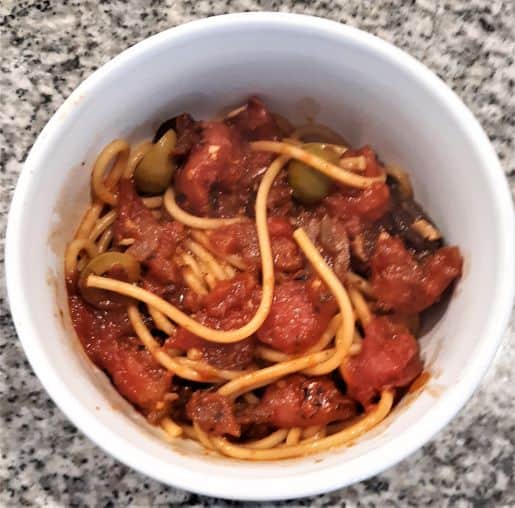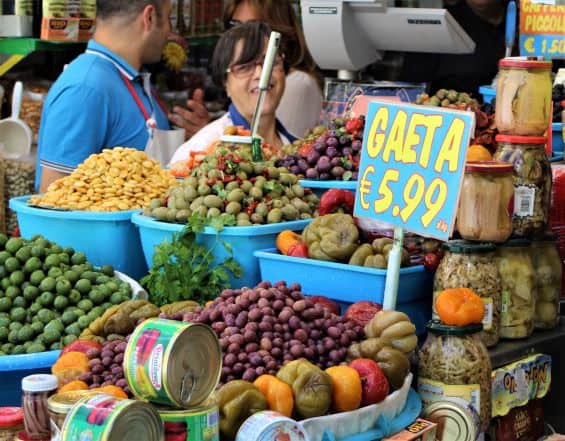Puttanesca translates literally to “prostitute.” So, Spaghetti alla Puttanesca is “pasta in the style of a prostitute.” That couldn’t be where this came from, could it?
Spaghetti alla Puttanesca origin story

The story goes that prostitutes in Naples would cook this quick dish of spicy tomato sauce and spaghetti to give their clients more energy.
Really?
Not to be crass, but why would a lady of the evening care if their customer had more energy or not, they got paid either way.
Another legend says that brothels would cook vats of sauce to lure men into their lair. Again, a good story, but really? I don’t think anyone is choosing a house of ill repute due to the quality of their marinara.
A more plausible story is the one that comes from Ischia, an island in the Bay of Naples. One evening in the 1950’s, Sandro Petti, co-owner of the famous Ischian restaurant Rancio Fellone (now closed), was getting ready to go home for the evening when a group of hungry customers sat down. Sando told them he didn’t have anything to serve them. They replied “Facci una puttanata qualsiasi” which roughly translates to “Make is whatever shit you have.”
You see, in addition to meaning prostitute, “puttana” is also an all-purpose slang term meaning “shit.” In this case, puttana means “stuff.” So, the customers are, in essence, saying “just make us whatever you got on hand.”
Sando took a few tomatoes, some olives, and a few capers and made a sauce. His creation was so popular that Spaghetti alla Puttanesca became a permanent fixture on Rancio Fellone’s menu.
Other possible origins of Spaghetti alla Puttanesca
Of course, not everyone buys the story of Spaghetti alla Puttanesca being a Sando Petti invention.

There are 19th century recipes from Campania that feature tomatoes, olives, and capers. There’s also some who credit Sicily with inventing the sauce. And let’s face it, tomatoes, olives, and capers were plentiful around Italy for over 100 years before Sando tossed them together. It’s likely that dishes similar to Spaghetti alla Puttanesca were floating around the peninsula for decades. But, Sando Petti’s story is a good one, so let’s go with it.
Variations on Spaghetti alla Puttanesca
Like all good recipes, Spaghetti alla Puttanesca is adaptable and several regional variations have sprouted up around Italy.
The best known version of Spaghetti alla Puttanesca is from Naples and features anchovies and oregano. The Roman version adds garlic. In Sicily, the dish is made with green peppers. But, in Palermo, you’ll find olives, anchovies, and raisins.
Recipe
My version of Spaghetti alla Puttanesca is vegan, so it omits anchovies completely. I’m also not a fan of capers, so out they go. Still, this recipe retains the sweetness and brineyness of the original.
Traditionalists will tell you that without capers, this isn’t real Spaghetti alla Puttanesca. Maybe not, but to that I say, the original was made with whatever was on on-hand, so I’ve adapted it to my taste.
I prefer bucatini for my pasta since the hollow noodle soaks up the tomato sauce so nicely; purists can use spaghetti.
Ingredients
16 oz of bucatini (use spaghetti if unavailable)
2 Tbsp olive oil
1 28 oz can whole tomatoes
1 small yellow onion, chopped
6 cloves garlic, minced
1 Tbsp tomato paste
1 cup chopped Gaeta olives (or other high quality black olives)
1/4 cup sun dried tomatoes
1 tsp red pepper flakes (less if you want it less spicy)
1/2 tsp dried oregano
1/4 cup fresh basil (or parsley), chopped (optional)
Zest of 1/2 lemon, grated
Salt and black pepper
Method
Rehydrate the sun dried tomatoes in a cup of hot water.
Boil well-salted water in a large pot.
Heat 2 Tbsp of olive oil in a sauté pan over medium heat. When oil begins to shimmer, add the chopped onion and a pinch of salt. Cook the onion until translucent and add the chopped garlic. Cook on medium or medium/low heat for 1 minute, stirring regularly to prevent burning.
Add the tomato paste and red pepper flakes and cook for 30 seconds.
Remove sun dried tomatoes from the water and chop. Reserve the water.
Add the sun dried tomatoes and olives and cook for 1 minute.
Put the can of tomatoes in a bowl and crush with your hands until they are in small pieces. Add the tomatoes, lemon zest, and oregano to the onion mixture. Simmer on medium/low heat for 10 minutes.
While the tomato sauce is cooking, drop the pasta into the boiling water.
Once the pasta is al dente, drain the pasta. Depending on the consistency of the sauce, add 1/4 to 1 cup of sundried tomato rehydration water to the sauce. At this point, stir to incorporate the water and taste. Add salt/pepper as needed.
Remove the sauce from the heat and add the pasta and sauce to the large pasta cooking pot. Combine and top with the optional chopped basil or parsley.
Serve hot.
About the Author

Brent Petersen is the Editor-in-Chief of Destination Eat Drink. He currently resides in Setubal, Portugal. Brent has written the novel “Truffle Hunt” (Eckhartz Press) and the short story collection “That Bird.” He’s also written dozens of foodie travel guides to cities around the world on Destination Eat Drink, including in-depth eating and drinking guides to Lisbon, Porto, Sintra, Monsaraz, and Evora in Portugal. Brent’s podcast, also called Destination Eat Drink, is available on all major podcasting platforms and is distributed by the Radio Misfits Podcast Network.
